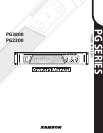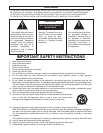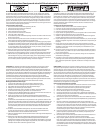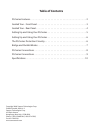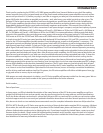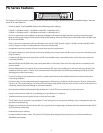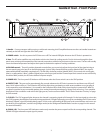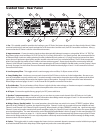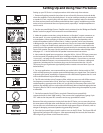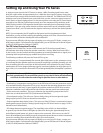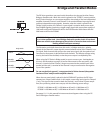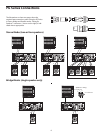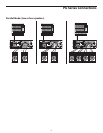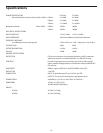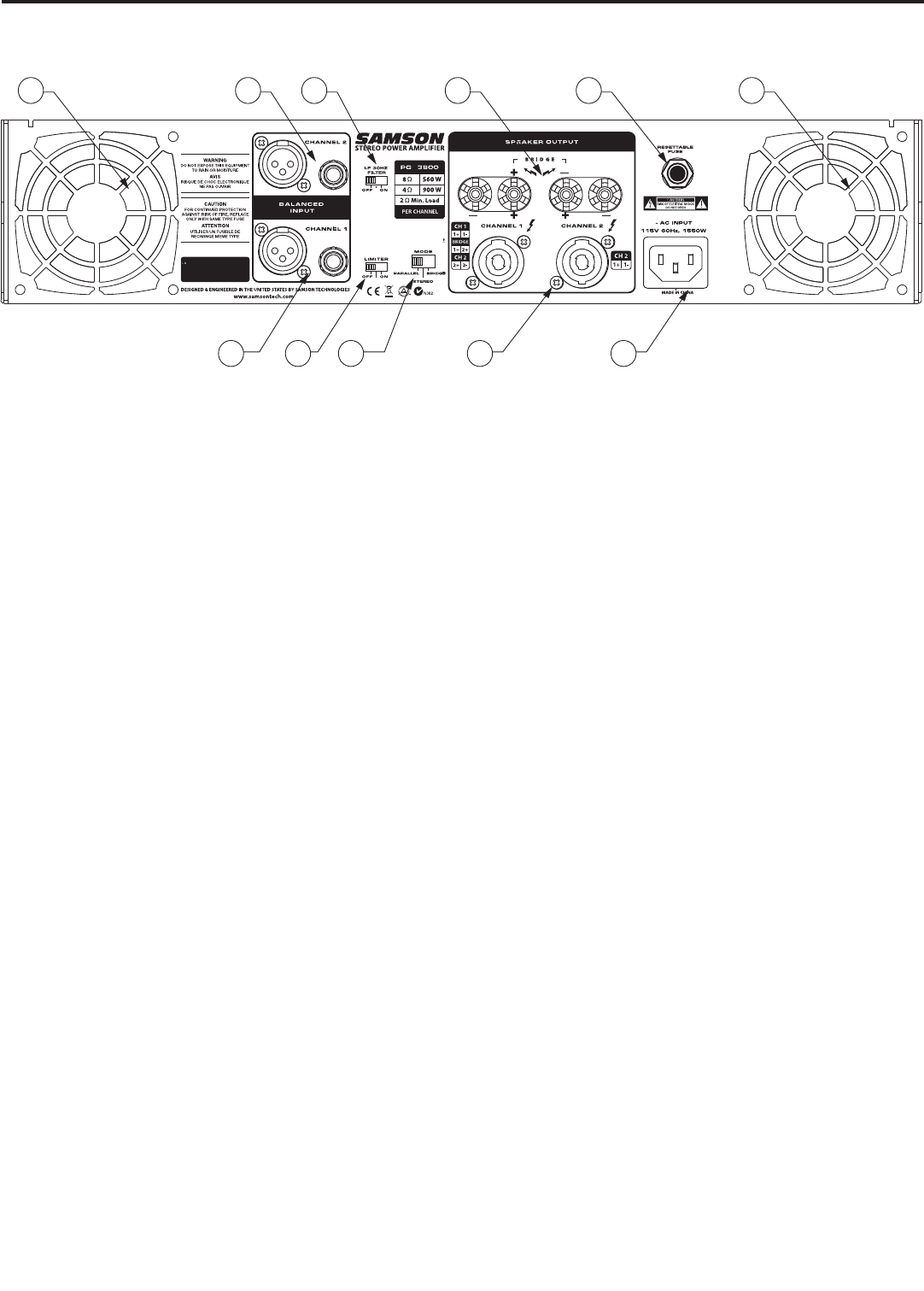
Guided Tour - Rear Panel
1: Fan - This variable-speed fan provides vital cooling to your PG Series (the hotter the amp gets, the faster the fan blows!). Make
sure that both the front and rear panels are kept free of all obstructions and that cool, fresh air is accessible at all times. Also, try
to ensure that the PG Series is used in a dust-free environment.
2: Input connectors - Connect incoming signals to these electronically balanced connectors, using either XLR or 1/4" TRS (Tip/
Ring/Sleeve) plugs, wired as follows: Pin 2 (or Tip) hot, Pin 3 (or Ring) cold, and Pin 1 (or Sleeve) ground. We recommend the use
of balanced three-conductor cabling wherever possible (unbalanced two-conductor 1/4" plugs can also be inserted into these
inputs, but you’ll get better signal quality and less outside noise and hum if you use balanced lines). The PG Series accepts input
levels of any strength but needs at least +4 dBu to achieve maximum power. Stereo signals should be connected to both the
Channel 1 and Channel 2 input jacks; however, when operating the PG Series in Bridge or Parallel modes, use the Channel 1 input
jack only. See page 9 in this manual for more information about Parallel mode and pages 10 and 11 in this manual for full inter-
connection instructions.
3: Low Frequency Filter - This toggle switch is used to engage a low cut filter, 12 dB per octave at 30 Hz.
4: 5-way Binding Post - Use these to connect each channel of the PG Series to 4-ohm or 8-ohm loudspeakers. Be sure to con-
nect the loudspeaker correctly, with the red (+) terminal normally connected to the positive input of the speaker and the black
(ground) terminal normally connected to the negative input of the speaker. See page 9 in this manual for more information
about Bridge mode and pages 10 and 11 in this manual for full speaker connection instructions.
5: Circuit Breaker - This circuit breaker will trip if there is a fault with the mains voltage or if maximum output is exceeded (very
highly distorted). Push it in (once only!) to restart the amplifier after a short rest period.
6: AC input - Connect the supplied heavy-gauge 3-pin “IEC” power cable here.
7: Speakon™ output connectors - Alternatively, you can use these to connect each channel of the PG Series to 4 or 8-ohm
loudspeakers. See page 9 in this manual for more information about Bridge mode and pages 10 and 11 in this manual for full
Speakon™ connector wiring and interconnection instructions.
8: Bridge / Stereo / Parallel switch - For normal operation, place this three-way switch in its center (“STEREO”) position. When
placed in its left (“PARALLEL”) position, the signal arriving at the Channel 1 input only is routed to the power amplifiers of both
Channel 1 and Channel 2 (the Channel 2 input is ignored). When placed in its right (“BRIDGE”) position, the signal arriving at the
Channel 1 input only is again routed to both power amplifiers (again, the Channel 2 input is ignored), but the two power amplifi-
ers are bridged together. For more information, see the “Bridge and Parallel Modes” section on page 9 in this manual and the “PG
Series Connections” section on pages 10 -11 in this manual. WARNING: Due to the extremely high power output of the PG Series
when used in Bridge mode, be sure to use only loudspeakers sufficiently rated to handle the resultant wattage (in Bridge mode,
these must be 4 or 8-ohm speakers).
9: Limiter - This toggle switch is used to engage the Limter circuit, an automatic dynamics processor used to hold the input signal
at a fixed threshold level which helps keep a clean signal and protect the connected speakers.
1
2 43 15
6792 8
4



